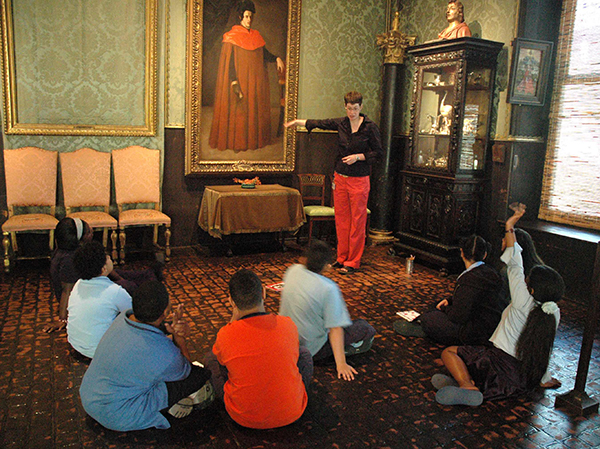
Reframing Art
Art is an essential element of our human experience, offering aesthetic pleasure as well as a method for expressing and contemplating meaning.
But what if art could also be used as a vehicle for building critical thinking and communications skills? That is the premise and promise behind Visual Thinking Strategies (VTS), an educational program developed more than 20 years ago by Philip Yenawine and Abigail Housen.
Recently I attended the VTS annual institute because I believed we shared many of the same assumptions and goals with respect to teaching and learning, and I wanted to learn more. Over four days of experiential training, I had time to contemplate VTS connections to math education in general and more specifically to Bridges in Mathematics.
 Elementary students discuss works of art in the Isabella Stewart Gardner Museum in Boston, MA.
Elementary students discuss works of art in the Isabella Stewart Gardner Museum in Boston, MA.
A VTS session begins with students taking a moment to look at a piece of art. The teacher then guides an exploration using three simple questions:
- What’s going on in this picture?
- What do you see that makes you say that?
- What more can we find?
Throughout the session the teacher carefully paraphrases, using neutral language and linking ideas to previous comments as appropriate.
Connections to Math Education
From observing classroom video clips as well as my direct experience in practice sessions, I agree with the VTS team that there are direct connections between VTS and the Common Core State Standards. In particular, the excerpts below from the Math Practices illustrate the skills and behaviors that VTS encourages and elicits from students.
- MP1: Make sense of problems and persevere in solving them. Proficient students start by looking for entry points. They make conjectures, rather than simply jump into a solution attempt. They consider analogous problems, and they continually ask themselves, "Does this make sense?" They can understand the approaches others take to solve complex problems and identify correspondences between different approaches.
- MP3: Construct viable arguments and critique the reasoning of others. Proficient students make conjectures and build a logical progression of statements to explore the truth of their conjectures. They justify their conclusions and communicate them to others. They can listen or read others’ arguments, decide whether they make sense, and ask useful questions to clarify or improve the arguments.
- MP6: Attend to precision. Proficient students try to communicate precisely to others. They try to use clear definitions in discussion with others and in their own reasoning.
- MP7: Look for and make use of structure. Proficient students look closely to discern a pattern or structure. They also can step back for an overview and shift perspective. They can see complicated things, such as some algebraic expressions, as single objects or as being composed of several objects.
Connections to Bridges in Mathematics
Both Bridges and VTS share a constructivist and inquiry-based philosophy. In addition, each program is based on the belief in the power of visual images to stimulate thinking and learning.
The many models and manipulatives that form the foundation of Bridges are natural candidates for rich VTS discussions. I shared the free apps from MLC with attendees at the institute and hope the many talented VTS educators will be motivated to experiment with incorporating these virtual manipulatives into their class discussions.
Number Corner calendar markers also have much in common with the VTS process, as students predict the next image based on observations of those currently displayed. I imagine these class discussions already feature many of the same elements of a VTS session.
I would encourage all educators, but particularly Bridges schools and districts, to consider implementing VTS. I believe you’ll find Visual Thinking Strategies a powerful way to build your learning community.
Rick Ludeman is president of MLC.